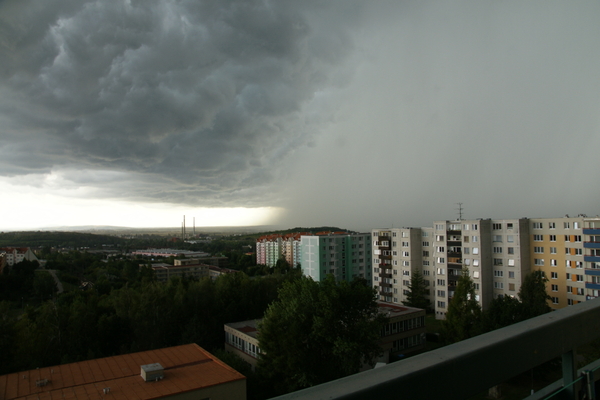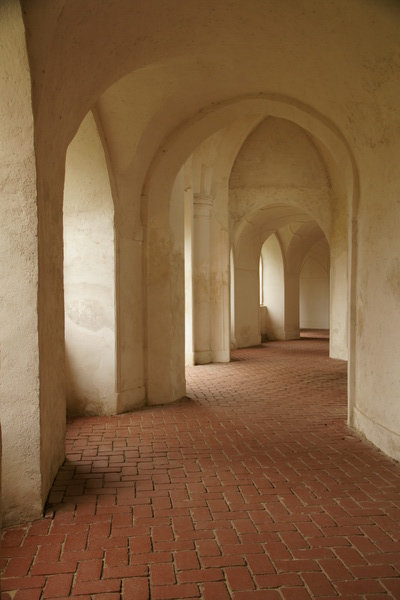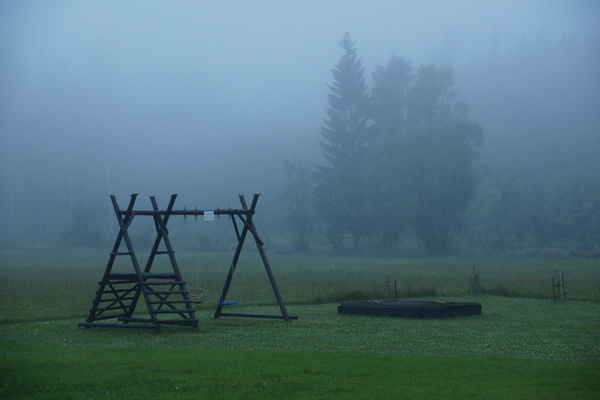Tue, 19 Aug 2008
New Laptop: Is Bigger Better?
I am considering buying a new laptop instead of my old ASUS M6R. The biggest problem is that I don't know whether I want a big or small one (see below). My requirements for a laptop are:
- No preinstalled Windows - I don't want to pay a Microsoft tax.
- No nVidia graphics. I want it to be as much open-specs as possible, so either Intel or ATI (even shared-memory one, as I don't need much 3D power).
- Long battery life (but I don't know what does it mean today).
- Bluetooth, 2+ USB ports, built-in camera.
- Under 20,000 CZK (about 800 Euro).
- At least 2 GB RAM. For my workload RAM is what matters most.
- SD and possibly CF card reader would be nice.
- Three or four mouse buttons would be nice, but apparently these times laptops instead of two scrolling buttons which could be easily configured as middle mouse button, tend to have a fingerprint reader.
- Probably a dual-core CPU around 2 GHz (my Pentium M 1.5 GHz is mostly able to play HD video, so in fact I don't need much more CPU power).
When one wants to go shopping for the above specs, it becomes obvious how badly designed various computer e-shops are, not even speaking about the vendor pages: for example ASUS Czech has its laptop section divided into the following subsections: Business, Digital home, New concept, Personal entertainment centre, Portability, Perfect mobility, and Display size. How TF am I supposed to know whether I want a "New concept" notebook or a "Perfect mobility" one, when my most important feature is "No Windows"? There are only two exceptions: Mironet and Alza. Their e-shops allow to filter laptops according to various criteria, including "No OS". The only problem is with graphics card - the "no nVidia" is impossible to choose - user would need to enable all other graphics cards (not vendors) one-by-one.
Anyway, the filtering gave me the following two laptops: ASUS F3E (15.4", Core2 duo 2.4 GHz, Intel graphics and WiFi, up to 3 hours on battery, not sure how good is its Linux support), and MSI PR210X (12.1", Turion X2 2 GHz, ATI integrated graphics, Atheros WiFi, 4 hours on battery, works with Linux). I am surprised that I am still not sure whether I want a 15.4" laptop or 12.1" one. Having a small laptop would definitely be nice, but strictly speaking, I don't need it: when I want to be ultra-portable, I have my Nokia n810. Any suggestions, my dear lazyweb?
14 replies for this story:
Honza wrote: Display
With small notebooks, it's the display what matters most for me. I saw one of the Apple MacBooks (13"), which I would never consider on the specs alone. Thanks to pretty good display, I really liked it. I have no idea how these two (ASUS and MSI) compare, though.
Booran wrote:
Yenyo co to resis jak nejaka sekretarka, jsi predci chlap od IT a mel bys vedet ze na linux jen a pouze (IBM) Lenovo ThinkPad ! :)
Adelton wrote:
If everything goes well, I should have EEE 1000 at FUDCon, so you can check whether 10" option isn't what you want.
Yenya wrote: Re: Adelton
Well, 10" definitely does not hold two 80-column xterms side-by-side. And for only one xterm, I have n810.
Yenya wrote: Re: Booran
Noone has ever been fired for buying IBM, isn't it? No, I do not buy into this kind of FUD. Choosing only ThinkPad and not considering other possibilites is exactly the "approach of a secretary" (or a manager) you criticize. Besides, thinkpads below 20,000 CZK do not have a webcam, look ugly (like every other IBM hardware), and it is not possible to buy them without Windows. I was satisfied with Linux on my ASUS M6R, so for Linux laptops there are definitely other vendors than Lenovo.
Lumir wrote:
With regard to ThinkPad and Windows license the article below is quite interesting reading: http://www.abclinuxu.cz/blog/kamil_paral/2008/8/vraceni-licence-windows-u-lenovo-cr
Yenya wrote: Re: Lumir
I know about it, but it is unusable for me in case the laptop is paid by my employer.
Miroslav Suchý wrote: Czechcomputer.cz
http://www.czechcomputer.cz/product_search.jsp?doc=DF0B721BD0CFAD51C1256DE5007C99C0 you can use operators = != and like. And you can either choose from predefined list or write your own term.
Pichi wrote:
To Miroslav Suchý: =, != and like is not enought to say NOT LIKE "Windows%"
Milan Zamazal wrote:
I've got one of the MSI things (bigger one, 15" I think). It satisfies most of your requirements except for battery life (I'd say at most 2 hours with powernowd). My observations (especially in comparison with my old HP notebook): Big, relativelly light, excellent price, many peripherals, feels cheeply built, good keyboard layout including real numeric keypad, but not very pleasant to touch, poor screen (glossy, even worse than my 6 years old HP, but I'm afraid you won't find anything better in your price range), unsupported graphics card (fglrx needed), unsupported wifi card (my colleagues can run it with ndiswrapper, I couldn't), poor sound, very poor sound input even with external microphone, no idea about camera (what is it good for?). Basically you get what you pay for. Overall the equipment and performance are very good considering the price, Linux runs on it although non-free drivers may be needed, you don't pay for Windows, quality is IMHO inferior (but it's possible to buy extended warranty for reasonable price).
Yenya wrote: Thinkpad note
You Lenovo fanboys may find the following blogpost interesting: http://pavelmachek.livejournal.com/60867.html
Vladimir wrote:
I saw one really cheap with good processor (T8300) 320 GB HDD 2 GB RAM and also asus.. this all in 15.4" design for 16k CZK..the only disadvantage from my point of view is that it has glazy display.. I have HP 6510b in 14.1" design.. I like more that design and also battery is from different level (more than 3.5 h) but it has not camera in lid and I had to delete that recovery jehoVista partition :) HP: http://hewlettpackard.mironet.cz/hp-6510b--t8300--ke132ea--2gb--160gb--dvdrw-141quot--vibs+dp82940/ ASUS: http://asus.mironet.cz/asus-f3eap367-t8300--2gb--320gb--dvdrw--154quot--bt+dp85291/ there is also priority service certificate in mironet :) ^^^ comparing price/performance this is my winner and one more think consider: the type of display (4:3/16:9). When writting code for example this widescreens are absolutelly useless.. but I have 20" 4:3 desktop LCS :) HOWGH
Spes wrote:
http://www.linuxjournal.com/video/review-hp-2133-mini-note http://h10010.www1.hp.com/wwpc/cz/cs/sm/WF25a/321957-321957-64295-306995-306995-3687084.html
Yenya wrote:
Just a side note: having my n810, I don't need another ultraportable like ASUS eee or HP 2133. Anyway, I have ordered an ASUS F3E.
Reply to this story:
Thu, 14 Aug 2008
Orange Sunglasses and Chromatic Aberation
I bought a new sunglasses for use on my bicycle. Somebody recommended orange colour because of supposedly better levelling between shade and light (which I often need, esp. on the forest roads), so I went for orange ones. I have discovered that when riding a bycicle, I see the edges of shadows coloured asi if my eye had chromatic aberation:
The edges where the sunny part is nearer to me tend to be blueish, while the opposite edges are yellowish. It is only visible when in move. When I stop, the aberation disappears. Can anybody explain this? The "when moving only" part could be explained by focusing to a different part, and seeing the shadows only marginally. Or is it a known optical illusion?
2 replies for this story:
va wrote:
I can't say anything to your "error" (never seen such thing), but I think orange color is not a good choice. I use sunglasses on a motorcycle and I have had several colors (mostly orange or grey - theese are the top sellers), now I strongly prefer blue and I can also recommend yellow. When you use orange, brown or grey, then the world looks like it is cloudy or dark and in theese conditions I can't fully enjoy my ride. Yellow sunglasses has the opposite effect - it seems to be nice weather even if it's cloudy and eyes are very comfortable. Blue ones are neutral in this way (no "weather effect" for me), the light is very comfortable for my eyes and I think they have the effect of "boosting" the colors of semaphores (other sunglasses - including yellow - have IMHO opposite effect) - which is maybe not such important on bicycle. :-)
Vasek Stodulka wrote:
^ That was me. :-)
Reply to this story:
Wed, 13 Aug 2008
Password Manager
Leaving the PalmOS platform, I need a new tool for storing my passwords securely (I have been using GNU Keyring with its JPilot conduit so far). What do you use for your passwords? Is it secure, easy-to-use, synchronizable both with other computers (think using the password data from home and work computers) and with other platforms (Nokia maemo in my case)?
I am thinking about GNOME Revelation, but I am not sure about its synchronization abilities. The other options are Gringotts (which has a maemo port as well), pwsafe (which is said to be compatible with Bruce Schneier's passwordsafe), or gpassman.
4 replies for this story:
valor wrote: Keepass
http://keepass.info/download.html -- I like this one, as I was looking for something for WindowsCE, originally. It keeps the passwords saved in one binary file that can be synchronized as an ordinary file over all platforms.. perhaps :)
Owen wrote: GNUKeyring isn't as Palm specific as you think!
For your desktop: http://www.lieder.dsl.pipex.com/software/JavaKeyring/ (for the best look and feel, run with something like: -Dawt.useSystemAAFontSettings=lcd_hrgb -Dswing.defaultlaf=com.sun.java.swing.plaf.gtk.GTKLookAndFeel) For your Maemo: http://handheldshell.com/software/pyring.php Cheers, Owen
Petr "Stone" Hracek wrote: Keepass
I've been using Keepass on my work as well. it has port also for Windows and Linux. In my home I am using only Linux and therefore it was neccessary to have both clients. In Windows is also Freeware called PasswordSafe which has some more features but it has not port to Linux yet
Tomáš Pecina wrote: Revelation + Gpasman
I solved the problem by using Revelation on my PC(s) and gpasman on the N810. I even wrote a simple conversion utility for syncing my tablet with the PC. The opposite direction is not easily possible as gpasman stores less data than Revelation (and it does not timestamp the entries). It will have to be done manually. Fortunately, I haven't needed it yet.
Reply to this story:
Tue, 12 Aug 2008
Alpha 700
My old camera stopped working with any memory card bigger than 512 MB, so I have finally decided to buy a true D-SLR. Having several Minolta-A mount lenses and a Minolta-compatible flash, I have decided to buy a Sony Alpha, which is a successor of Minolta (later Konica-Minolta) cameras.
I had a great dilemma choosing between α350 and α700 (both links point to in-depth reviews at dpreview.com). The first one is a newer "higher entry-level" SLR with 14.2 megapixels, live view on a tilting LCD display, etc. The latter is a semi-pro body about a year older, 12.2 megapixels, bright pentaprism (cf. pentamirror in α350) viewfinder, etc. But no live view.
After reading the above reviews and the article "Which Sony Alpha?", which directly addressed my dilemma, I have decided to go for a slightly more expensive α700 (the difference was not so big because I wanted the SAL 16-105 lens, which is sold in a set with α700, but has to be bought separately for α350).
Want to see the photos? Look at the last page of the above reviews. Some of my own photos are here (not edited, just scaled down; click for the full version):

This one has been taken by my wife.

From a tearoom in Hlinsko, IIRC.

Zelená hora in Žďár nad Sázavou.

Even the photos in a foggy weather are not bad.
So, after several weeks of using α700, I can wholeheartedly recommend it. Maybe it does not have many exceptional functions, but for many of them there are dedicated buttons, which means you can actually use those functions in real life shooting. Nobody who is in a hurry would use functions hidden in some deep menus. Also their dynamic-range optimization really works and is useful, as well as their anti-shake system built in the body (instead of in the lens, like other vendors). So far I have found only one drawback: the exposure bracketing can bracket by at most 0.7 EV steps, which makes shooting frames for HDR[?] photos from hand difficult. The only workaround I have discovered is to use five frames instead of three, which gives you a range of +/-1.4 EV. Another drawback is that my home workstation is too slow to handle 12-Mpix files, so I would probably have to upgrade soon.
UPDATE 2008/11/20: Fixed in new firmware
The version 4 firmware adds a wider EV range of bracketing (upto +/- 2 EV),
so the problem with usability for taking HDR photos from hand is gone. Good.
On the other hand, the α900 full-frame body is out now, so my α700 is
officially obsolete now :-/
2 replies for this story:
Milan Zamazal wrote:
Congrats to your new toy! :-) Two questions: 1. How are you satisfied with using your old lenses on the digital body? Any picture quality problems? 2. I've heard that in cameras of another vendor it's better to switch off the in-body stabilization when you don't need it. This is because the sensor shakes all the time so if you take a snapshot from a stable tripod and with a good lens, the stabilization makes the final picture less sharp. Did/would you make some experiments about it?
Yenya wrote: Re: Milan Zamazal
As for the old lenses, the 50/1.4 is still excellent (the second picture above is taken with it, IIRC). As for 100-300/4.5-5.6, I took only few photos so far, but I did not find any problem. I did not try to use an old kit 28-80 and a Soligor 17-35, as they are both for APS-C format surpassed by the 16-105. I have the image stabilization always on. I can do test on a tripod, but so far I have been satisfied even with the photos taken on a tripod.
Reply to this story:
Mon, 11 Aug 2008
What's Wrong With GIMP?
I have recently came across this discussion under the article at Root.CZ. More than half of the discussion is centered around GIMP and its (un)usability.
Every now and then I read those complaints: the GIMP user interface is bad, user-unfriendly, unintuitive, etc. As a casual GIMP user, I do not get it: for me, GIMP is easy to work with. As far as I can remember, when learning to work with it (and having previously used only simple bitmap editors like XPaint), the most mentally difficult feature for me were layers. Once I got used to what layer means and what can I do with it, I found it quite natural and intuitive.
Do you also find the GIMP unintuitive and hard to use? What part exactly you do not like?
11 replies for this story:
Vasek Stodulka wrote:
Yes - I am allways looking forward to work with GIMP, because it is something else then my other work. I have installed GIMP to our (blonde :-) secretary, beacuse she asked me to buy "Photoshop". I expected some chat about "the horrorible GUI" or so, but she came a week later and said, that she likes the program very much and asked me, if I can provide her a CD with some cracked version, so she can install it at home. She looked really confused, when I provided her only a web link and talking about free software...
Abraxis wrote: What I hate about GIMP
Things I personally hate about GIMP: - lot of separate windows appearing in task manager (IIRC - in Windows), no option to switch it to MDI-style - non-standard look'n'feel (at least in Windows and probably also in KDE) - no simple painting tools (draw circle/box/...) - some effects don't have "Preview" function I haven't used GIMP in quite a time, so maybe some issues are fixed now. Somehow using GIMP leaves me a bad taste in mounth (heh)... really very subjective feeling ;-)
otakar wrote: Co mi vadí na GIMPu?
Nechápu, co lidé vidí neintuitivního na GIMPu. GIMP je podle mne mnohem intuitivnější než Photoshop, se kterým jsem se naučil slušně pracovat již dříve. Když jsem pak zkusil GIMP, okamžitě jsem se zorientoval. Všechno je totiž přesně tam, kde se to dá předpokládat. Abraxis v příspěvku výše má pravdu, že chybí kreslicí nástroje, ale to jako velký problém nevidím - je to jen otázka jednoho kroku navíc. Mně chybí hlavně podpora více než 8bitových barev, vrstvy úprav, a v neposlední řadě také efekty vrstev. I přesto ale pracuji s GIMPem moc rád.
Yenya wrote: Re: Abraxis
Well, circle can be drawn by selecting it and then Select->Stroke. Look & feel is perfectly OK in GNOME (after all, it is GTK+ app). I did not like MDI-style apps, and I welcome GIMP letting window manager do its work. Otakar mentions some GIMP drawbacks (which I agree with), but they are definitely not an UI issue.
Milan Zamazal wrote:
I stopped using GIMP completely several years ago, exactly for its horrible GUI. It's important to say that I don't paint bitmap pictures, I just do photo editing. And for photo editing GIMP was so horrible that I started to write (and use) my own photo editor. I later abandoned that project when digiKam appeared, providing civilized photo editing GUI in its showfoto editor. GIMP might got improved during the years, I don't know, I haven't run it for long time and I'm satisfied with showfoto + Krita enough not to care about GIMP anymore. So, what was exactly wrong with GIMP? One *functional* problem was that it was able to work only with 8-bit colors (it would be a fatal problem for me now, making any GUI problems insignificant). GUI problems started with its "numerous windows" approach, especially in a tiling window manager. The most annoying thing was the cropping tool, not providing comfortable way to make ratio crops and being prone to mouse misclicks. Opening a file dialog on directories with many files took ages to start. Everything looked cumbersome and requiring more mouse clicks than needed. Limited preview facilities. I can't recall all the details but the basic GUI problem for me was that for the few typical photo editing operations I needed the GUI wasn't fast enough to operate. Showfoto is great tool and pleasing to use, although not everything is perfect for me. I use Krita for operations which showfoto can't do. It's hard to learn how to use it (well, I should probably read its manual sometimes), but it's a single window application at least (and it can work with 16-bit colors, of course) so it's usable for me.
Vasek Stodulka wrote:
May I ask a question - what are more then 8-bit colors good for? The most of displays are nowadays 6-bit (sad, but true), better are 8-bit (so we can say our 8-bit pictures are for theese hi-tech guys) and even if I use good old CRT with possibility of displaying practically unlimited number of colors, then I need some graphics card capable of working with more colors and AFAIK only some Matroxes were able to show 40bit colours. When it comes to printing, then - I do not understand it well - but the printer basically uses 4 or 6 colors and even if the milions-to-six-colors algorithm was able to recognize and dither more then 8-bit colors, then you can use different type of paper or different ink and finally the colors will not fit anyway. So you can't see it, you can't print it and if you don't look at the data in some hex editor, you don't have any proof, that you have more then 8-bit color picture. (And even if you look at the data in hex editor, how can you proof, that the last bits are not some random mess?)
Yenya wrote: Re: Vasek Stodulka
In fact, most people can see about 7 bits of greyscale depth. However, you need more for editing. Things like white balance, gamma correction, contrast stretch, etc. can generate visible artifacts when done on an 8-bit image. You can open your photo in GIMP, open the Colors->Levels, look at the histogram, do some modification (say change gamma to 0.9 or 1.1), apply, and then open the same dialog again. When you look at the histogram, it is striped, so not all levels of gray are now present in the image.
otakar wrote: Re: Milan Zamazal
Krita je hezká, ale také má do dokonalosti daleko. Především jí chybí naprosto nejzákladnější nástroj, a to úprava jasových křivek (nebo jsem magor a neumím hledat - trochu omezenou možnost jsem našel ve vrstvách úprav). Také má jen velmi primitivní možnosti například u rotace nebo perspektivy, nemá editovatelné výběry... Pokud jde o ořez v GIMPu, má velmi bohaté možnosti nastavení, včetně poměru stran, a rozhodně náchylný na chybné kliknutí není ;-)
Milan Zamazal wrote: Re: otakar
Já Krita používám pouze na věci, které neumí showfoto a přitom je potřebuji, tzn. klonování a jasové gradienty. V bitmapové grafice dělám pouze úpravy fotek, takže nemohu posoudit jiné rysy. Ohledně ořezu v GIMPu, může na tom být dnes už lépe a taky jsou věci, které někomu vadí a někomu ne, ale tenkrát jsem při jeho používání nadával jak špaček :-).
otakar wrote: Re: Milan Zamazal
Ohledně toho ořezu - patrně jsi pracoval s ořezem, který je například ještě v CinePaintu - tam je opravdu potřeba přesně mířit :-) Již dlouhou dobu (nevím přesně od které verze) má ořez (i výběr) široké okraje pro editaci. Dělá se s tím nádherně. Také používám GIMP jen na úpravy fotek (hlavně pro webovou fotogalerii) a právě ořez, jasové křivky a rotace jsou nejpoužívanější nástroje. Jinak si fotky nechávám v originále, protože protáhnout je 8bitovým editorem by nebyl nejlepší způsob archivace. Nadějně pro 16bit vypadá použití GEGL (i když je to s ním nepříjemně pomalé i na 2jádru).
Lukas wrote:
Moje posledni zkusenost s GIMPem: 1. zapnul jsem to 2. udelal novy obrazek 3. skryl jsem pravitka 4. zavrel a otevrel jsem GIMP 5. zjistil, ze si to nepamatuje nastaveni pravitek (nebyla skryta, jak jsem je mel predtim) 6. zavrel sem GIMP
Reply to this story:
Mon, 04 Aug 2008
Won a Lottery
There are things that can be bought for money, and there are things that cannot. The following one is from the later category:
From: Theodore Ts'o
Subject: Maintainer's Lottery: Invitation to the 2008 Kernel Summit
Greetings,
This year, we will be hosting the 2008 kernel summit in Portland,
Oregon, just before the Plumber's Conference.
[...]
This year, we are continuing the MAINTAINERS lottery which we start last
year. The way the lottery works is that we pick 5 people at random from
the MAINTAINERS list and invite them to attend the kernel summit.
[...]
:-) As you may have guessed, you were picked in the lottery, and we hope
that you will be able to join us.
Yay! Now to get the visa paperwork done and to secure the funding :-)
6 replies for this story:
davro wrote:
Hmmm, looks like spam :-)
Yenya wrote: Re: davro
Yep, I have almost missed it - my spam filter marked it as "unsure".
Vasek Stodulka wrote:
Just for motivation - I won a ticket for (Czech) "Distribution of the year" ceremonial similar way. Finally I was not able to get there, but it looks I missed a good party. I wish you better luck. :-)
Milan Zamazal wrote:
Great, enjoy it!
Peter Kruty wrote: Sounds good!
I hope your visa application goes well and you will make a nice blog post from summit :).
Vlastimil Holer wrote:
Cool.